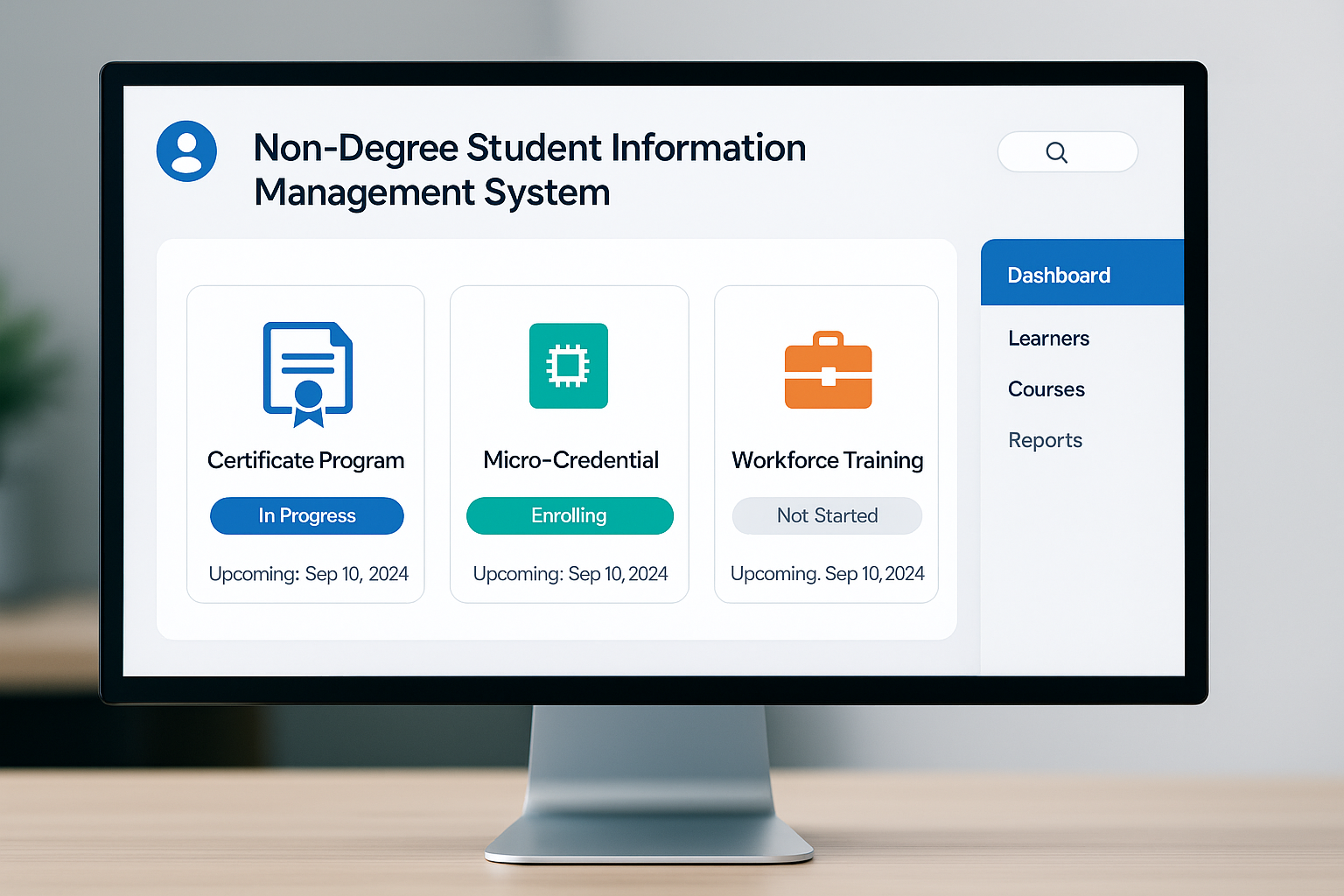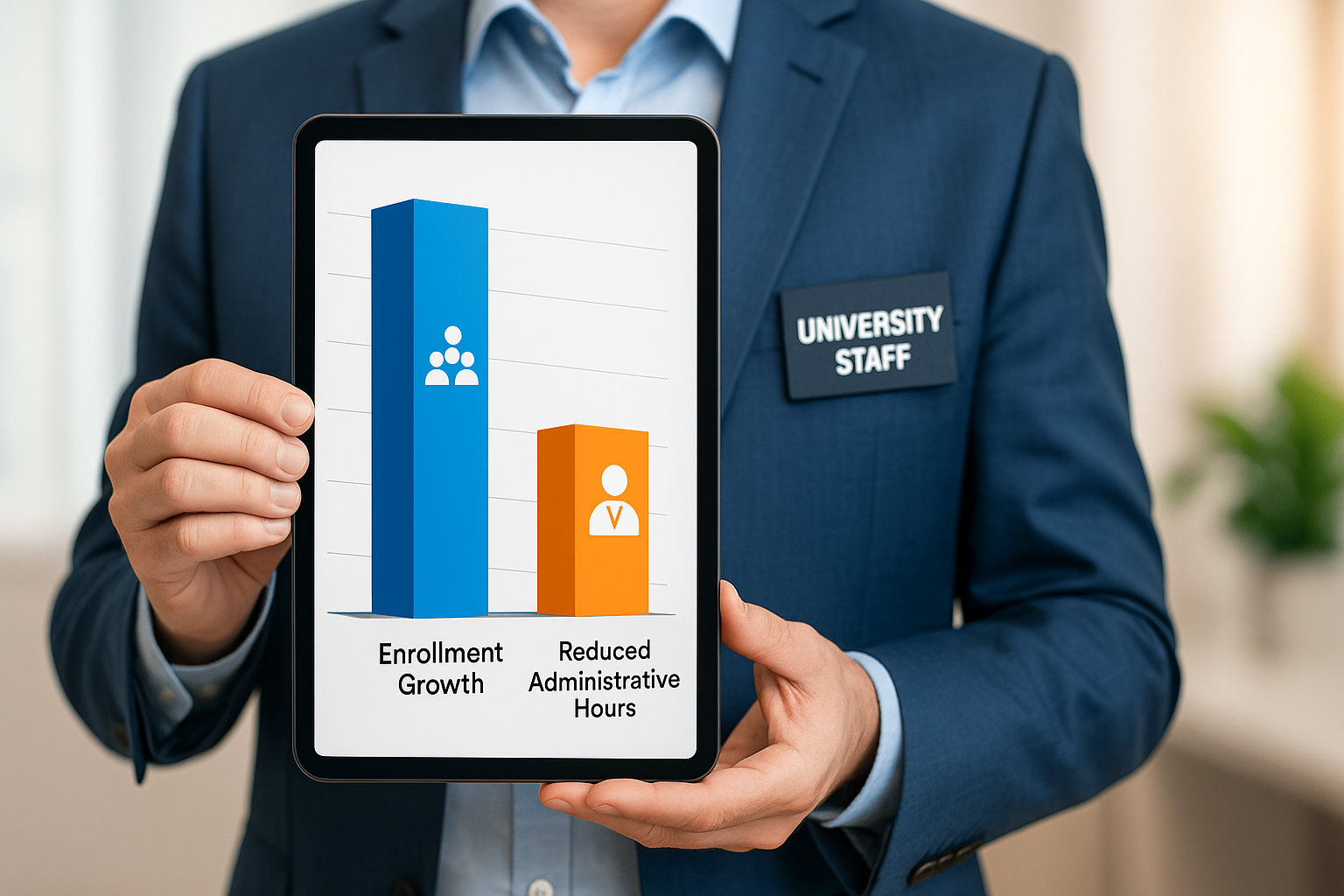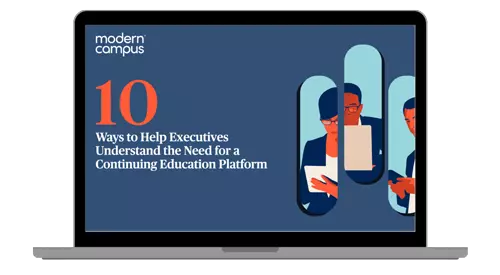
A non-degree student management system is an online platform that allows non-degree units to manage their learners' experiences across continuing education, workforce development, professional certification and lifelong learning programs. These specialized systems serve the growing population of non-traditional learners (working professionals, career changers and adult students) who seek flexible, outcome-oriented education that aligns with their personal and professional goals.
Unlike traditional degree programs, non-degree offerings encompass diverse formats including micro-credentials, professional certificates, industry certifications and skill-based training programs. These learners often juggle multiple responsibilities, pursue education while working full time and expect streamlined, consumer-grade digital experiences that respect their time and autonomy. They're driven by specific career outcomes and return on investment, requiring systems that can adapt to their unique learning pathways and scheduling needs.
The challenge lies in the fundamental mismatch between traditional academic systems and the dynamic, market-responsive nature of non-degree education. While conventional platforms excel at managing semester-based, full-time degree programs, they struggle to accommodate the agility, personalization and rapid deployment that modern continuing education demands.
In this guide, you’ll know everything you need to know about non-degree student information management systems, which are the cornerstone of continuing education (CE) management software. This includes:
- What is a Student Information System?
- What is a Non-Degree Student Information System?
- What is the Importance of a Non-Degree Student Information System?
- How is a Non-Degree Student Information System Different from a Traditional One?
- Who Needs a Non-Degree Student Information System?
- What Problems Can a Non-Degree Student Information System Solve?
- What are the Benefits of a Non-Degree Student Information System?
- Is Your Unit Ready for a Non-Degree Student Information System?
Why Non-Degree Student Management Systems Are Essential
Non-traditional students, those who are often older, not coming directly from high school or have job and family responsibilities, now constitute the majority of college students. This demographic shift comes at a time when higher education faces unprecedented challenges. The number of 18-year-old high school graduates will peak in 2025 at around 3.9 million, followed by a 15-year decline.
While traditional college-age populations shrink, institutions are seeing growth in non-traditional segments. Undergraduate certificate program enrollment grew for the fourth consecutive year, up 9.9 percent in fall 2024 (+101,000). Enrollments are now 28.5% above 2019 levels, according to the National Student Clearinghouse Research Center. This growth trend extends to other flexible educational formats, with community colleges seeing a 5.9 percent increase, or 325,000 additional students, primarily driven by learners seeking workforce-relevant credentials and continuing education opportunities.
The data reveals a fundamental shift in higher education demand. While the traditional college-age population will peak and then begin a steady decline, there has been an increase in the number of non-traditional students. However, most non-traditional students drop out of college before earning a degree or credential, which affects an institution's enrollment and revenue numbers. This trend creates an urgent need for specialized management systems that can support these learners' unique pathways and improve retention outcomes.
The demographic decline and growing non-traditional enrollment make implementing a robust non-degree student management system advantageous and essential for institutional sustainability. As traditional pipelines narrow, the colleges and universities that can effectively attract, engage and retain non-traditional learners through specialized systems will be best positioned to thrive in the evolving educational landscape.
What is a Student Information System?
Online student information systems (SIS) are digital repositories for student information. Though different systems have different functionalities, most will store and track student data such as grades, transaction records and more. An SIS is an online source for learner and school information—data provided by the learner to the school and vice versa.
These systems have become integral to smooth learner-to-institution communication. Learners use it to gain access to crucial information regarding programs, pay for courses and connect with the institution. Administrators and select faculty use them to access all relevant information pertaining to the learner's academic experience.
The student information system acts as a channel for communication and a source of key information for learners and staff.
What is a Non-Degree Student Information Management System?
A non-degree student information management system is built specifically for non-degree units. Any program or offering that doesn't end with a student receiving a traditional credit is considered “non-degree” (other terms that may be used are “continuing education,” “non-credit education” or “workforce development”). Workforce development technology serves an institution’s workforce education efforts, encompassing certificates, certifications and more.
Non-credit offerings require more flexible administration processes than their credit-bearing counterparts. Since 24 to 37% of higher ed students are non-traditional students, the non-credit experience is now more important than ever. Non-degree student management systems meet these needs with technologies that serve the unique expectations of the units that host them and the learners that use them, using practices that align with the model of lifelong learning that characterizes the modern learner.

A non-degree student information management system allows Continuing Education and Workforce Development units to manage every aspect of their non-traditional learners’ experience while promoting efficiency throughout the unit, which saves time.
Importance of a Non-Degree Student Database Software
Non-Degree Student Database Software is critical for engaging, enrolling and retaining the modern learner. It’s also key to streamlining the management of non-credit programs and students, as traditional SIS don’t allow CE units the agility needed to manage the experience without considerable time and effort.
Today’s students have an increasing number of resources for their professional development. As veteran consumers, they expect seamlessness in their digital interactions. When alternatives to traditional education are exploding, a Continuing Education platform or a web-based student information management system is a non-negotiable for success.
Modernized, CE-specific administration is the best way to align a non-credit unit with the modern learner’s needs.
Differences With a Traditional Education Administration Software?
Though many institutions prioritize a one-size-fits-all approach to managing their respective units, there are major differences between what a traditional SIS and a non-degree student management system can offer.
| Non-Degree Student Information System | Traditional Student Information System |
| Tailored to non-traditional learner needs, serving students throughout their entire lifecycle | Built to serve the needs of young adults in credit-bearing programs (“one-and-done” education) |
| Serves the alternative credential market with digital microcredentials (badges) and stackable outcomes (bundling) | Serves degree-oriented programs alone, limiting market reach |
| Gets offerings to market quickly with fast-tracked approval and launch processes, outpacing market demand | Frequently slow turnaround for new courses and programs, falling short of market demand |
| Dedicated portals for students, corporate partners, families, international agents and other key stakeholders; increasing scope of access outside traditional learner base | Limited use of dedicated portals, often only differentiating between student and staff; tight scope of user access |
|
Offers corporate engagement platform to ease workforce training enrollment and management for partners |
Offers management of for-credit programs only |
| Class registration software that modernizes shopping experiences, so they’re accessible to all learners with shopping cart, self-service and reminder functionality | Complicates learner’s shopping experience through outdated and/or ineffective online shopping practices, resulting in lost conversions or reliance on administrative support |
Who Needs a Non-Degree Student Management System?
Continuing Education and Workforce Development units require management software that addresses their staff and learners' unique needs, providing specific insight into students' performance and records.
Without a dedicated CE platform providing relevant data, insights and management capabilities, many will fail to meet the needs of today’s learner. As a result, they will see engagement, enrollments and revenue drop as prospective students look elsewhere to meet their needs.
While all non-degree units benefit from an SIS built for non-credit education, those experiencing a modern learner engagement gap are the ones that most need modernized administration provided by a student information system.
Benefits of a Student Information System for Higher Education
Non-degree software for higher education feeds non-credit units everything they need to engage, enroll and retain non-traditional learners. Using technologies specific to CE boasts many benefits that aren’t available to those using traditional student database information systems.
Amazon-Like Digital Experience
A non-degree student information and management system makes the learner’s digital experience seamless. It can save students time with advanced search functions that allow them to quickly find the information they’re looking for. They want very few clicks, fast checkout practices and personalized information to provide an experience that keeps them engaged and drives them to enroll.
Multiple Conversion Points
Non-degree software for higher ed feeds non-credit units everything they need to engage, enroll and retain non-traditional learners. Using technologies specific to Continuing Education boasts many benefits that aren’t available to those using traditional student database management systems.
A non-degree SIS seizes every point of contact with a learner as an opportunity to convert. It optimizes pages for maximum findability through search engines and engages learners with an elegant and clear interface. It moves learners through the enrollment funnel with website personalization and pathways software to help learners navigate your offerings.
Learner Personalization
Non-degree student management system software gives learners relevant information that helps them understand what programs and courses they should take to meet their goals. It offers critical labor market information such as salary expectations and job growth forecasts so learners can clearly see their return on investment.
Automated Workflows
Non-credit student information management software automates many of CE staff’s more tedious workflows. With repetitive tasks automated and business processes streamlined, administrators can direct their hours toward meaningfully serving non-traditional learners and growing the institution.
Automated Course & Prerequisite Management
Continuing Education management software collects any information a learner might need to enroll in your offerings and automatically connects it to the institutional website, LMS and course calendar to ensure learners receive the right information at the right time.
The SIS also automates course approval and publishing processes to notify the people every time administrators need their sign-off, getting your programs to market more quickly.
Flexibility & Customization
A Continuing Education platform is designed with your own needs for customization in mind, allowing you to pivot at a moment’s notice to modify offerings, improve your institution’s website, incorporate new software and more.
Non-credit student information management system partners can also dedicate support staff to more complex operational customizations with a low turnaround, so administrators are never left waiting.
A non-degree SIS turns your unit’s digital experience into an enrollment-generating machine that attracts, enrolls and retains learners throughout the entire student lifecycle.
Measuring the ROI of Non-Degree Student Management Systems
As institutions adapt to serve an evolving student population, measuring the return on investment (ROI) of technology solutions, especially those supporting non-credit programs, is critical. A non-degree student management system enables Continuing Education and Workforce Development units to generate clear financial and operational returns by enhancing both learner experiences and administrative outcomes.
From an enrollment perspective, institutions using a dedicated non-degree student information management system can launch offerings faster, personalize outreach and simplify the enrollment process, ultimately boosting registration rates and program revenue. With adult learners often preferring non-degree education pathways, this responsiveness is a competitive edge and a necessity.
Beyond top-line growth, these systems drive down operational costs by automating time-intensive processes like registration, course scheduling, prerequisite tracking and approvals. This reduction in manual workload empowers staff to focus on innovation and learner engagement, improving retention and long-term value per learner. The right platform transforms continuing education units from cost centers into scalable growth engines for the institution.

What Problems Can a Non-Degree Student Information System Solve?
Non-degree higher ed software can be the remedy for many issues that Continuing Education and Workforce Development units experience.
Here are a few of the administrative issues that continuing education management software can resolve.
Inefficient Non-Credit Administration
When non-credit units use main campus systems to manage their offerings and engage their learners, inefficiencies arise. CE units often wind up overly reliant on their colleagues on the main campus for support in completing the simplest of tasks, from registration and enrollment to gathering metrics. Similar problems are present in units using an offshoot of a main campus system, or any SIS that isn’t built for non-degree education’s needs.
Continuing Education is expected to be responsive, customer-centric and innovative, but building a CE unit on the back of a system designed for traditional higher ed can create significant headaches for staff whose time could be better spent elsewhere.
A non-degree student information management system can eliminate or reduce the inefficiencies that slow workflows and divert staff from division-growing work.
Poor Student Experience
Modern learners expect a seamless registration and enrollment experience that puts them in the driver’s seat. They want to manage as much of their engagement with the institution as possible and perform tasks (like registration, payment and course management) online at their own pace.

Most higher education software is not designed with the non-traditional student in mind. Oftentimes, it’s full of tedious processes of on-campus administration in a digital environment. This doesn't align with the seamless consumer experiences modern learners have with most eCommerce retailers. The best college and university allow learners to direct their own administration.
The convoluted and confusing experience provided by outdated systems can be addressed with modernized non-credit systems and a tailored student information system designed specifically for continuing, workforce, professional and online education.
Learn how to choose a modernized SIS for your non-credit unit.

Is Your Unit Ready for a Non-Degree Student Information System?
If your unit is relying on for-credit systems to manage non-credit learners, it may benefit greatly from non-credit higher education software.
The overwhelming majority of Continuing Education units that implement non-degree administration software realize new efficiencies and increase enrollments and revenue within months of going live.
If your unit is suffering from transactional student relationships, declines in enrollment, revenue or a digital experience that doesn't match modern customer standards, consider more effective administration methods. Prioritizing a system that enables seamless digital experiences for both learners and staff can remediate these issues and more.
A non-degree SIS transforms a non-credit unit’s digital experience to attract, engage and retain learners while automating time-consuming aspects of administration for staff. If you serve non-traditional learners, a non-degree student information system may be the right choice for you.
Learn how a non-degree student information system can drive enrollments, engagement and efficiency within your non-credit unit. Request a demo today.
Additional Resources

Primer
Student Lifecycle Management and the Learner Experience
Learn how a student lifecycle management platform can transform your learner engagement and customer service.

Whitepaper
How to Increase Continuing Ed Revenue with a Modern eCommerce Experience
Learn how using modern eCommerce principles drives revenue in Continuing Education.

Blog
4 Keys to Increasing Student Engagement in Today’s World
The higher ed ecosystem is changing, especially in regards to student engagement best practices. How institutions adapt will set the stage for the future.